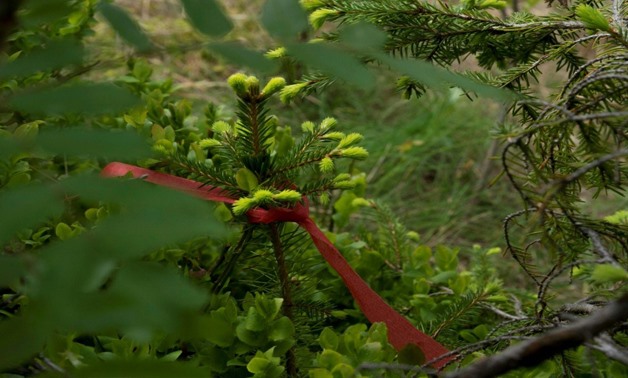
One thousand Norwegian spruces, decorated with a red ribbon and planted in an Oslo forest clearing, will provide the paper — in 2114 — for the “Future Library”. AFP photo
Oslo - 28 June 2017:Some will never know if their books were appreciated by readers, many of whom aren't born yet. Every year for 100 years, a different author will contribute to the "Future Library", a collection of works to be published only in the next century.
So far, 1,000 Norwegian spruces planted three years ago are the only visible sign of this internationally and stylistically diverse project, each little shrub decorated with a red ribbon in a modest clearing in a forest on the outskirts of Oslo.
Once they reach 100 years old, in 2114, the trees will be chopped down and used to make paper for anthologies compiling the works of the invited writers.
Canadian author Margaret Atwood was the first one asked to join the initiative in 2015, followed by English novelist David Mitchell in 2016. This year Icelandic poet Sjon submitted his manuscript -- one, his contemporaries will, in all likelihood, never read.
"One of the things an author will always deal with is the fact that there will be readers the author never knows.
"They might be on another continent and they might be far away in time.
But it's very rare to know that no one will read the text while you are alive," says Sjon, who also writes lyrics for Icelandic singer Bjork.
Knowing that he would never see any reactions to his piece "made my relationship with the text very deep," he explained.
"I realised that many of the mechanisms I take for granted as I write my texts are really something that I need to think about all the time: the precision of words, using old words...
"Writing in my language, which is the Icelandic language, was also one of the questions I was faced with because I don't know where my language will be in 100 years."
While normally it is the blank page that awaits the author's divine inspiration, this time it is the authors' words that have to wait for the tree to turn into the pages of a book.
The long wait for the "Future Library" is just the latest in a string of initiatives in Norway celebrating "slow life" and posterity.
The Scandinavian country is the champion of "Slow TV" -- a 134-hour boat journey through the fjords was broadcast live. A 24-hour mostly live broadcast of salmon fishing and 12 hours on the topic of firewood are among other marathon "slow TV" coverage.
It is also home to a "doomsday" seed storage vault designed to protect the world's crops from disaster forever after.
And thanks to its abundance of oil, it has also amassed the world's largest sovereign wealth fund, officially destined to fund the welfare state for future generations.
The idea for the library took root in the imagination of Scottish artist Katie Paterson and was able to grow following a meeting with Norwegian real estate developers hunting for cultural projects.
"The authors of today or in a decade's time or several decades will hopefully say something of this moment," Paterson says.
"I think that will be very interesting for those who get to read the manuscripts in 100 years. Because they can reflect all the way back in time because, 100 years later, who knows what that civilisation is going to be?"
But, will we still be reading books in 2114? Will there still be machines to print books?
The "Future Library" is "a vote of confidence in the future of culture," said David Mitchell last year.
"I think it was Umberto Eco, who said the form of the book can never be improved upon. It's like the wheel, there's no improvement," says Paterson.
"But, of course, technology advances so fast that, I think what feels extremely unknown is that - now we talk about digital books -- but we have no idea what the form of the book might be.
"It might be something completely unimaginable to us. So maybe the paper book might be an antique by then," she says.
"That's for the future to know."
A total of 1,000 limited-edition copies of the anthologies will be published. Certificates entitling holders to a copy will be sold gradually over the years for $1,000 (around 900 euros) in art galleries.
Pending the release of the secret works in the next century, the manuscripts will be locked up in a specially designed room at the new Oslo Public Library, due to be opened in 2020.
Drawing a light-hearted comparison with real estate development in which she works, Anne Beate Hovind, who heads the overall project and the selection committee that chooses the writers, acknowledges its unconventionality but stressed the "Future Library" carried prestige for those writers involved.
"If we had to do a risk assessment of this artwork, it would have never happened," she said smiling.
"But we're competing with the Nobels now."


Comments
Leave a Comment